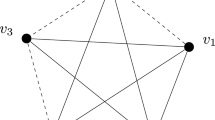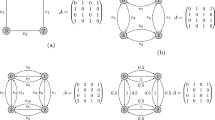Abstract
The Szegedy’s quantum walk can give rise to a quadratic speed-up when the Markov chain is ergodic and symmetric. However, the quantum search on a one-dimensional (1D) cycle graph does not achieve a speed-up. In this paper, we study the effects of self-loops on the 1D cycle by Szegedy’s quantum search. First, with the help of self-loops, Szegedy’s quantum search can increase the success probability of finding a marked vertex on the 1D cycle. Second, the general expressions for the evolving states and the success probability on the 1D cycle with self-loops are explicitly presented by the symmetric tridiagonal matrix. The evolution of success probability is slower and smaller with the increase in the weight of the self-loops. Third, an approximate entanglement formula of the success probability is derived by a concave function, where the entanglement is measured by the reduced von Neumann entropy. The existence of a turning point is confirmed, and it was found to depend on the maximum eigenvalue of the initial superposition state and the number of marked vertices. Before the turning point, the entanglement first increased and then decreased.














Similar content being viewed by others
References
Štefaňák, M., Jex, I., Kiss, T.: Recurrence and pólya number of quantum walks. Phys. Rev. Lett. 100(2), 020501 (2008)
Ambainis, A., Prūsis, K., Vihrovs, J., Wong, T.G.: Oscillatory localization of quantum walks analyzed by classical electric circuits. Phys. Rev. A 94(6), 062324 (2016)
Anantharaman, N.: Quantum ergodicity on regular graphs. Commun. Math. Phys. 353(2), 633–690 (2017)
Kajiwara, T., Konno, N., Koyama, S., Saito, K.: Periodicity for the 3-state quantum walk on cycles. Quantum Inf. Comp. 19, 1081–1088 (2019)
Ambainis, A., Kempe, J., Rivosh, A.: Coins make quantum walks faster. In: Proceedings of the sixteenth annual ACM-SIAM symposium on Discrete algorithms, pp. 1099–1108. Society for Industrial and Applied Mathematics
Shenvi, N., Kempe, J., Whaley, K.B.: Quantum random-walk search algorithm. Phys. Rev. A 67(5), 052307 (2003)
Wong, T.G.: Grover search with lackadaisical quantum walks. J Phys. A-Math. Theor. 48(43), 435304 (2015)
Szegedy, M.: Quantum speed-up of markov chain based algorithms. In: 45th Annual IEEE Symposium on Foundations of Computer Science (2004)
Wong, T.G.: Equivalence of Szegedy’s and coined quantum walks. Quantum Inf. Proc. 16(9), 215 (2017)
Paparo, G.D., Martin-Delgado, M.: Google in a quantum network. Sci. Rep. 2, 444 (2012)
Santos, R.A.M., Portugal, R.: Quantum hitting time on the complete graph. Int. J. Quantum. Inf. 8(05), 881–894 (2010)
Santos, R.A.M., Portugal, R., Fragoso, M.D.: Decoherence in quantum Markov chains. Quantum Inf. Proc. 13(2), 559–572 (2014)
Wong, T.G., Santos, R.A.: Exceptional quantum walk search on the cycle. Quantum Inf. Proc. 16(6), 154 (2017)
Prūsis, K., Vihrovs, J., Wong, T.G.: Stationary states in quantum walk search. Phys. Rev. A 94(3), 032334 (2016)
Wang, K., Wu, N., Xu, P., Song, F.: One-dimensional lackadaisical quantum walks. J Phys. A-Math. Gen 50, 505303 (2017)
Wong, T.G.: Faster search by lackadaisical quantum walk. Quantum Inf. Proc. 17(3), 68 (2018)
Jozsa, R., Linden, N.: On the role of entanglement in quantum-computational speed-up. Proc. R. Soc. A Math. Phys. Eng. Sci. 459(2), 2011–2032 (2003)
Li, Y., Qiao, Y., Wang, X., Duan, R.: Tripartite-to-bipartite entanglement transformation by stochastic local operations and classical communication and the structure of matrix spaces. Commun. Math. Phys. 358(2), 791–814 (2018)
Pan, M., Qiu, D., Zheng, S.: Global multipartite entanglement dynamics in Grover’s search algorithm. Quantum Inf. Proc. 16(9), 211 (2017)
Pan, M., Qiu, D., Mateus, P., Gruska, J.: Entangling and disentangling in grover’s search algorithm. Theor. Comput. Sci. 773, 138–152 (2019)
Pan, M., Qiu, D.: Operator coherence dynamics in grover’s quantum search algorithm. Phys. Rev. A 100(1), 012349 (2019)
Shi, H., Liu, S., Wang, X., Yang, W., Yang, Z., Fan, H.: Coherence depletion in the grover quantum search algorithm. Phys. Rev. A 95(3), 032307 (2017)
Fang, Y., Kaszlikowski, D., Chin, C., Tay, K., Kwek, L., Oh, C.: Entanglement in the grover search algorithm. Phys. Lett. A 345(4–6), 265–272 (2005)
Marshall, A.W., Olkin, I.: Inequalities: Theory of Majorization and Its Applications. Academic Press, Cambridge (1979)
Acknowledgements
This work is supported by the National Natural Science Foundation of China (Grant Nos. 61871120 and 61502101), Natural Science Foundation of Jiangsu Province, China (Grant No. BK20191259), the Six Talent Peaks Project of Jiangsu Province (Grant No. XYDXX-003), and the Fundamental Research Funds for the Central Universities.
Author information
Authors and Affiliations
Corresponding authors
Additional information
Publisher's Note
Springer Nature remains neutral with regard to jurisdictional claims in published maps and institutional affiliations.
Appendices
Appendix A Proof of Eq. (59)
When \(m = 1,k = 1\) in Eq. (27), according to the definition of the integral, we can derive
When \(m = 1,k > 1\) and k is odd,
where f does not change. So
Case 1: for the coefficient of \(\left| {{c_{1,1}}} \right| \),
Since \( - 2 \le \frac{{4\cos \left( {2{\theta _k}t} \right) }}{{\left( {1 + \cos {\theta _k}} \right) }} \le 2\), we have \(\left| {{c_{1,1}}} \right| < \frac{{2\sqrt{b} }}{{n\sqrt{n} }} \times 2 \times \frac{n}{2} = \frac{{2\sqrt{b} }}{{\sqrt{n} }}\). So
Case 2: for \(\left| {{c_{n,1}}} \right| \),
where \(\left| {\cos \alpha - \cos \beta } \right| \le \left| {\alpha - \beta } \right| \).
Since \(1 - \cos \left( {{\theta _k}} \right) \ge \frac{{{\theta _k}^2}}{8}\), then \(1 - \cos \left( {2{\theta _k}} \right) \ge \frac{{{\theta _k}^2}}{2}, \left( {0 \le {\theta _k} \le \frac{\pi }{2}} \right) \).
Then, \(\left| {{c_{n,1}}} \right| \le \frac{{\sqrt{a} }}{{\sqrt{n} }}\sum \limits _k {\frac{2}{{\left( {{\theta _k}} \right) }}} \frac{1}{n}\). Due to \({\theta _k} \approx \frac{k}{n}\) and k is odd, we can obtain approximately \(\left| {{c_{n,1}}} \right| \le \frac{{\sqrt{a} }}{{\sqrt{n} }}\sum \limits _k {\frac{1}{k}}\) (k is odd), where \(\sum \limits _k {\frac{1}{k}}\) is the harmonic series. When n is finite, the sum of the harmonic series can be calculated. Thus,
Case 3: for \(\left| {{c_{n,n}}} \right| \),
Case 4: for \(\left| {{c_{2,1}}} \right| \),
It is the same as \(\left| {{c_{1,1}}} \right| \), then
Case 5: for \(\left| {{c_{1,n}}} \right| \),
Thus, \({r_1} = \left| {{c_{n,1}} \cdot {c_{1,1}}} \right| + \left| {{c_{n,n}} \cdot {c_{1,n}}} \right| + \left| {{c_{n,1}} \cdot {c_{2,1}}} \right| < \frac{{2\sqrt{2ab} + \sqrt{2ab} + 2\sqrt{2} a}}{n}\), so
Compared to \({\lambda _{0\max }} = \frac{{ 4\sqrt{ab} + 6a}}{n}\) in Eq. (39), we can conclude \(\sqrt{2}{r_1} \le {\lambda _{0\max }}\) in Eq. (59).
When \(m \ge 2\), these results still hold by substituting \(m\ge 2\) into \(m=1\).
Appendix B Proof of Eq. (60)
Similar, \(m \ge 1\), when \(1 \le j \le n - m\), \(\left| {{c_{j,j}}} \right| \approx \left| {{c_{\mathrm{{1,1}}}}} \right| \le \frac{{\sqrt{2b} }}{{\sqrt{n} }}\), \(\left| {{c_{j,j + 1}}} \right| \approx \left| {{c_{\mathrm{{2,1}}}}} \right| \le \frac{{\sqrt{2a} }}{{\sqrt{n} }}\). Thus,
Appendix C Proof of Eq. (69)
Similar, \(m \ge 2\), where
Rights and permissions
About this article
Cite this article
Xu, M., Liu, Z., Chen, H. et al. Probability and entanglement evolutions for Szegedy’s quantum search on the one-dimensional cycle with self-loops. Quantum Inf Process 20, 51 (2021). https://doi.org/10.1007/s11128-021-02994-5
Received:
Accepted:
Published:
DOI: https://doi.org/10.1007/s11128-021-02994-5




